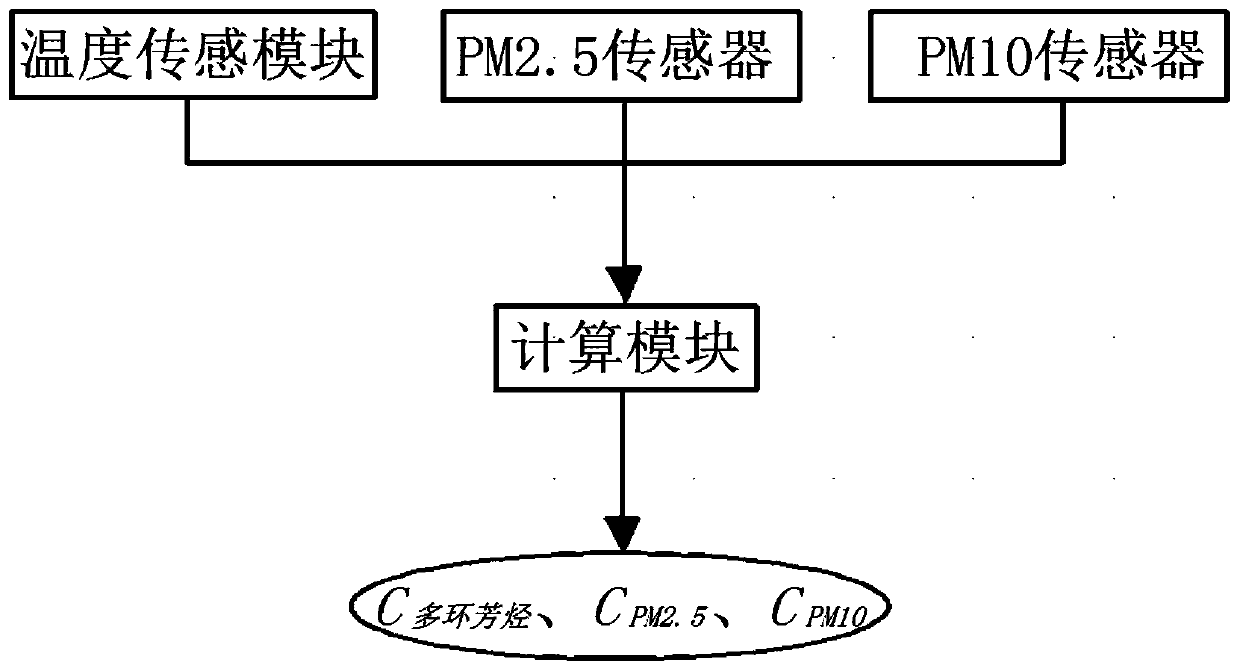Range hood with function of recognizing harmful gas and particulate matter in oil fume
A harmful gas and particulate matter technology, which is applied in the direction of oil fume removal, particle suspension analysis, household appliances, etc., can solve problems such as the inability to automatically identify the concentration of polycyclic aromatic hydrocarbons and particulate matter, and limit the intelligent development of range hoods.
- Summary
- Abstract
- Description
- Claims
- Application Information
AI Technical Summary
Problems solved by technology
Method used
Image
Examples
Embodiment 1
[0076] A range hood with the function of identifying harmful gases and particles in the range hood, such as figure 1 As shown, a smoke machine main body and a harmful gas and particle detection device are provided, and the harmful gas and particle detection device is electrically connected to the smoke machine main body.
[0077] The harmful gas and particulate matter detection device calculates the current concentration of polycyclic aromatic hydrocarbons in the cooking area according to the detected temperature in the cooking area and the concentration of particulate matter in the oil fume in the cooking area.
[0078] The harmful gas and particle detection device is equipped with a temperature sensing module for detecting the temperature in the cooking area, a PM2.5 sensor for detecting the concentration of particles with an equivalent diameter of A PM10 sensor with an equivalent diameter less than or equal to the concentration of particulate matter of 10 microns and a calc...
Embodiment 2
[0087] A range hood with the function of identifying harmful gases and particles in the lampblack, other features are the same as in Embodiment 1, the difference is that the calculation formula of the calculation module is formula (I),
[0088] C 多环芳烃 =0.05κ+0.002(C PM2.5 +C PM10 )+0.33κ(C PM2.5 +C PM10 )+475.1 ... formula (I).
[0089] where C 多环芳烃 is the total concentration of PAH gas in the cooking area, κ is the output data of the temperature sensing module, C PM2.5 is the output data of the PM2.5 sensor, C PM10 It is the output data of the PM10 sensor.
[0090] When κ∈(0℃, 200℃), (C PM2.5 +C PM10 )∈(0,3000μg / m 3 ), C (2-3) =70%C 多环芳烃 , C (4) = 20%C 多环芳烃 , C (5-6) = 10%C 多环芳烃 .
[0091] When κ∈(200℃, 240℃), (C PM2.5 +C PM10 )∈(3000μg / m 3 , 5000μg / m 3 ), C (2-3) = 60%C 多环芳烃 , C (4) = 25%C 多环芳烃 , C (5-6) = 15%C 多环芳烃 . where C (2-3) is the concentration of bicyclic PAHs and tricyclic PAHs, C (4) is the concentration of tetracyclic PAHs, C (5-6...
Embodiment 3
[0095] A range hood with the function of identifying harmful gases and particles in the lampblack, other features are the same as in Embodiment 1, the difference is that the calculation formula of the calculation module is formula (II),
[0096] C 多环芳烃 =0.05κ 0.98 +0.002(C PM2.5 +C PM10 ) 1.05 +0.33κ(C PM2.5 +C PM10 )+469.5 ... formula (II).
[0097] where C 多环芳烃 is the total concentration of PAH gas in the cooking area, κ is the output data of the temperature sensing module, C PM2.5 is the output data of the PM2.5 sensor, C PM10 It is the output data of the PM10 sensor.
[0098] When κ∈(0℃, 200℃), (C PM2.5 +C PM10 )∈(0,3000μg / m 3 ), C (2-3) =70%C 多环芳烃 , C (4) = 20%C 多环芳烃 , C (5-6) = 10%C 多环芳烃 .
[0099] When κ∈(200℃, 240℃), (C PM2.5 +C PM10 )∈(3000μg / m 3 , 5000μg / m 3 ), C (2-3) = 60%C 多环芳烃 , C (4) = 25%C 多环芳烃 , C (5-6) = 15%C 多环芳烃 .
[0100] where C (2-3) is the concentration of bicyclic PAHs and tricyclic PAHs, C (4) is the concentration of ...
PUM
 Login to View More
Login to View More Abstract
Description
Claims
Application Information
 Login to View More
Login to View More - R&D
- Intellectual Property
- Life Sciences
- Materials
- Tech Scout
- Unparalleled Data Quality
- Higher Quality Content
- 60% Fewer Hallucinations
Browse by: Latest US Patents, China's latest patents, Technical Efficacy Thesaurus, Application Domain, Technology Topic, Popular Technical Reports.
© 2025 PatSnap. All rights reserved.Legal|Privacy policy|Modern Slavery Act Transparency Statement|Sitemap|About US| Contact US: help@patsnap.com



